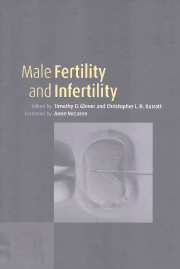Foreword by Anne McLaren, FRS
Published online by Cambridge University Press: 09 August 2009
Summary
The first part of this book is concerned with an account – comprehensive but sufficiently idiosyncratic to grip the reader's attention – of the evolution, anatomy and physiology underlying male fertility. The complexities of spermatogenesis are clearly explained. Few could fail to be intrigued by the discussion of penis length and its controversial evolutionary significance, or the information that rams can ejaculate thirty or forty times in one day, compared with a maximum of six for the human male.
Yet from the point of view of the book's editors, all this is mere back-ground to their primary concern. As the second part of the book reveals, it is ICSI, the intracytoplasmic sperm injection procedure, in which they are really interested. Many of us were astonished when it became apparent that a single spermatozoon, selected by the practitioner and possibly malformed and immotile, could through ICSI achieve fertilisation and finally the birth of a healthy baby as readily as conventional IVF. This remains true; but there is now abundant evidence that the genetic defects which may be responsible for the infertility of the ICSI patients may also be transmitted to their sons – hence the need for careful genetic counselling (and perhaps testing) of ICSI patients. Other problems with ICSI, and other challenges and opportunities for andrology in general, are discussed in the later chapters.
- Type
- Chapter
- Information
- Male Fertility and Infertility , pp. ix - xPublisher: Cambridge University PressPrint publication year: 1999

